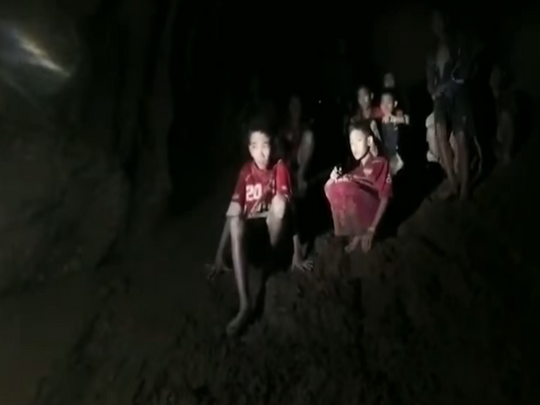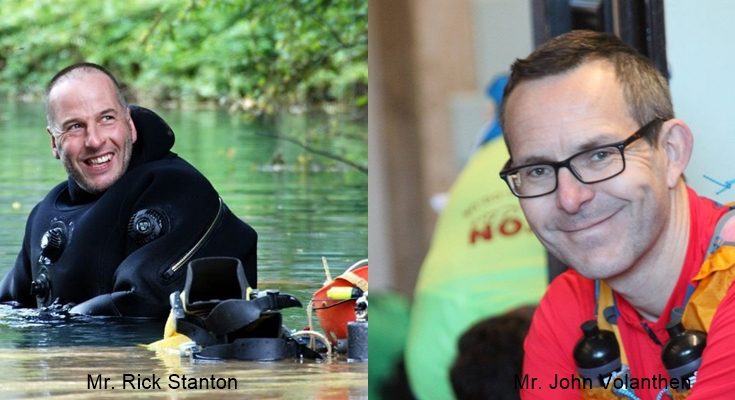
12 young boys and their football coach were discovered late on Monday, thin and hungry on a mound of mud surrounded by water deep in a Thai cave.
Rescuers are expecting a long and difficult evacuation of the boys, nine days after they went missing.
VIDEO: New footage of a youth football team trapped in the bowels of a Thai cave shows the boys laughing and saying they are well pic.twitter.com/W0ipwEL5eI
— AFP news agency (@AFP) July 4, 2018
What exactly happened?
A group of under 16 Thai youth footballers went missing on Saturday June 23. The boys, aged 11-15, are believed to have entered the Tham Luang Nang Non cave in Chiang Rai province with their 25-year-old coach late Saturday afternoon.
The search started after a mother reported that her son did not return from football practice that day.
The boys' bicycles and boots were found at the mouth of the Tham Luang caves, in the northern province of Chiang Rai.
There had been no contact with the boys, aged between 11 and 16, since they went missing with their 25-year-old coach last Saturday.
How did they get trapped?
They were believed to have been trapped by rising waters inside the cave network when heavy rain hit. The cave floods during Thailand’s rainy season.
About the cave
The chamber where the boys are located is about 4 kilometres from the entrance of the cave, which is thought to be about 6-8 kilometres long.
The cave, cut into a mountainside in far northern Thailand near the border with Myanmar, is a local tourist attraction but can flood severely during Thailand’s rainy season, which runs from June to October. Rain continued to fall in the area Monday afternoon and officials said parts of the cave were flooded under at least 5 meters of water.
What were the search and rescue teams doing?
The massive rescue effort had for days been hampered by heavy rains that flooded the Tham Luang cave in northern Thailand, blocking access to chambers where it was hoped the group would be found alive.
Even elite Thai navy SEAL divers were finding it difficult to move through the muddy waters, currents and tight passageways.
Last week, they still had hope they would find the boys. “We are still searching right now,” Chote Narin, an officer at Mae Sai district police station, said on Monday June 25 in the afternoon.
“We’ve found traces but no people yet.” He said footprints and handprints were found inside the cave complex and that officials believe the boys are still alive. He said the fact that they’re athletes should help them endure the situation.
"The team went down to a depth of 5 metres and found a large chamber... but we've found no trace of the children," the navy unit said on its Facebook page.
Now, the boys have been found
The search had been going on for 9 days until they found the boys alive on Monday night.
"We found all 13 safe... we will take care of them until they can move," Narongsak Osottanakorn, Chiang Rai provincial governor told reporters, who broke into spontaneous applause and cheering.
"We will bring food to them and a doctor who can dive. I am not sure they can eat as they have not eaten for a while."
Much-needed food and medical supplies - including high-calorie gels and paracetamol - reached them Tuesday as rescuers prepared for the possibility that they may be there for some time.
The condition of the group was not immediately clear after days underground.
Who were the british divers that found the boys?
“How many of you?” the diver asked.
“Thirteen,” a boy answered.
“Brilliant,” the diver said.
In footage of the moment the divers arrived in the chamber, a rescuer with an English accent is heard trying to reassure the group that help is coming.
The two British volunteer cave divers who were the first to locate the 12 Thai boys and their coach after nine days of searches are world leaders in cave rescue, and have frequently worked together on major search and rescue operations around the globe.

Bill Whitehead, head of the British Cave Rescue Council (BCRC), said Rick Stanton and his colleague Volanthen spearheaded the mission. “They were pushing ahead with the other divers following on behind, creating dumps of air bottles,” he said.
The plan is to feed and strengthen the boys then somehow get them out of the cave
"[We will] prepare to send additional food to be sustained for at least four months and train all 13 to dive while continuing to drain the water," Navy Captain Anand Surawan said, according to a statement from Thailand's Armed Forces.
Could they dive out?
In theory yes: but it is an extremely difficult task. Cave diving is already very risky, especially for young boys in a weakened state who have no diving experience.
Tham Luang cave where the boys have been trapped is one of Thailand's longest at 10 kilometres (six miles) and one of the hardest to navigate with its winding and at times narrow corridors.
If they dive, they have no choice but to follow the steps that rescuers took though tiny passageways clogged with mud and silt.
That journey takes a healthy - and skilled - Navy SEAL diver about six hours.
Officials said they would attempt to train the boys to use crucial diving gear after they are rehabilitated with food, water and medical support.
"Cave diving is a very technical skill and it's extremely dangerous, especially for an untrained diver," Anmar Mirza, coordinator of the US National Cave Rescue Commission, told AFP.
"So they may end up being better off trying to supply them in cave until they can be gotten out by other means."
Could they be dug out?
Explorers have spent days scouring the mountain top for possible alternative openings. They have found a few "promising" leads and have tried to drill deeper.
But there is no indication that any of those chimneys connect to the chamber where the boys have been stranded.
Again, the boys need to spend time getting stronger in the depths of the cave before they can attempt to climb up a second entry - if one is found - or be lifted out.
What about walking out?
This would be the safest option, but at the moment it is impossible because parts of the route remain flooded.
So in theory they could wait, but that means hoping that flood waters subside.
Water pumps are working around the clock to drain the floods though it has been an uphill battle for much of the week as heavy rains refused to let up.
If the current break in bad weather sticks, this option could be more promising.
But weather forecasters warn downpours may soon return as monsoon season sets in.
"If the rain fills up the cave system then that might take months before the water drops again," Belgian diver Ben Reymenants, owner of Blue Label Diving in Thailand who is assisting the search, told AFP.
How long could it take?
Hard to say for sure. It depends how long it takes for them to regain strength.
Experts say they could remain inside for weeks - or even months - as rescuers work out the safest option for their extraction.
The military said Tuesday it was preparing enough food for four months but did not speculate they could be in there that long.
Are the boys even in the right mindset to move?
They clearly want to leave. In footage that emerged after the boys were found by two British divers late Monday one asks to "go outside."
One of the diver replies "I know, I understand... no, not today."
Even if they are physically fit enough to dive, they will need the mental prowess to stay calm in the murky waters and claustrophobic passageways that stand between them and freedom.
Fortunately, they seem in pretty good shape, considering.
"They're mentally stable which is actually pretty good," Reymenants said.
"Luckily the coach had the sanity of mind to keep them all together, huddled together to conserve their energy that basically saved them."
-With inputs from AP, Guardian and Reuters










